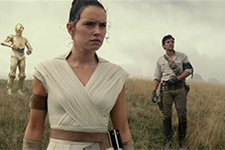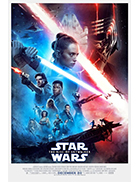Star Wars: The Rise of Skywalker
|  So here we are, 42 years and nine films into the official Star Wars “Skywalker Saga” that began in May of 1977 with the release of George Lucas’s original Star Wars (or Star Wars: Episode IV—A New Hope, if you want to be thorough). At the time, Lucas was so unsure of his film’s chances for success that he went to Hawaii on opening weekend so he wouldn’t have to be around if and when it bombed (it was during that Hawaiian trip, that Lucas and Steven Spielberg, who was there escaping his own woes during the post-production of Close Encounters of the Third Kind, cooked up the idea for Indiana Jones, but that’s another story …). How wrong he turned out to be. You would have to go back to Thomas Edison declaring that motion pictures, which he helped innovate, would be a passing fancy that lasted 10 years at best to find a more misguided movie predication. As we all know now, the original trilogy, which included Stars Wars, The Empire Strikes Back (1980), and Return of the Jedi (1983), turned into a cultural juggernaut that forever changed the movie industry (and its ancillary markets); in a sense, we are still watching movies in the house that Star Wars built. Lucas returned to the franchise he created in the late 1990s and early 2000s with a trilogy of prequels (1999’s The Phantom Menace, 2002’s Attack of the Clones, and 2005’s Revenge of the Sith) that charted the path of He-Who-Would-Become-Darth-Vader; it was a stew of mixed results, although hindsight has shown that Lucas’s consistency of vision across those three films was both admirable and challenging. That consistency is precisely what the third trilogy of Star Wars films, which began with J.J. Abrams’s Star Wars: The Force Awakens (2015) and was followed by Rian Johnson’s Star Wars: The Last Jedi (2017), lacks. The Force Awakens kicked things off in grand style by introducing an entirely new cast of characters—Daisy Ridley’s Rey, a resolute orphan with a Jedi future; John Boyega’s Finn, a rebellious Storm Trooper who joins the Resistance against the fascistic First Order; Oscar Isaac’s Poe Dameron, an ace Resistance pilot and owner of BB-8, a rolly-polly new droid; and Adam Driver’s Kylo Ren, a conflicted Sith lord who yearns to be the next Darth Vader—while also bringing back familiar faces three decades older, notably Harrison Ford’s Han Solo and Carrie Fisher’s Leia Organa, who we learned gave birth of Kylo Ren. Much of the new Star Wars world was successfully established, although some critics (and fans) griped that it looked and felt a bit too much like the old world. No matter—narratives were launched, characters created, and long-term mysteries established, particularly the tantalizing question of Rey’s lineage. Those questions were deepened—and in some ways conflicted—in Johnson’s The Last Jedi, which divided fans right down the middle. Johnson’s take on the material, particularly the return of Luke Skywalker (Mark Hamill), wasn’t to everyone’s liking (although I remain mystified as to why some decried it as the worst film in the series), so there has been great expectation that Abrams, in returning to the directing chair, would essentially “right” that film’s “wrongs.” The very fact that this would need to be done speaks to the lack of planning that went into this trilogy, which now viewed as a whole has a kind of awkward, slip-shod feel; the individual parts are all good in their own ways, but the series comes together only under obvious pressure and stress. Almost anything can be forced to fit together, but don’t look too closely at the seams. With The Rise of Skywalker, Abrams and co-writer Chris Terrio (working from a story concocted by Derek Connolly and Colin Trevorrow, the latter of whom was originally slated to direct) have delivered something that certainly passes for a fitting conclusion. There has been some griping about “fan service,” suggesting that Abrams is just kowtowing to Star Wars fans, which is basically the opposite of what Johnson did two years ago in taking the series in his own, idiosyncratic direction. That kind of criticism strikes me as absurd, since Abrams’s intentions are largely irrelevant and what matters is whether The Rise of Skywalker works both on its own as a film and as the capstone of the third trilogy in the Star Wars saga. On both counts, I would argue that it does. Imperfectly, sure, but it works. The first half hour is definitely the roughest, as we lurch from plot point to plot point in such rushed fashion that it’s hard to digest much of anything, much less enjoy it. The film opens with a massive “reveal,” showing us in the first 10 minutes that the mastermind behind all the evil doings from the previous two films has been none other than Emperor Palpatine (Ian McDiarmid), who was also the evil mastermind behind all the evils doings in both of the previous trilogies (his villainous bona fides were secured in both creating the Galactic Empire and turning Anakin Skywalker into Darth Vader). When we last saw the Emperor at the end of Return of the Jedi (when Ronald Reagan was President, mind you), Vader had hurled him into a void in the middle of the new Death Star where he apparently exploded. That, alas, was not enough to take him out, and it appears that he has continued to exist, albeit in weak, skeletal form, biding his time until he can re-energize himself and take command of the First Order—with Kylo Ren’s assistance, of course. The reveal of the Emperor is supposed to be a big kick, but it doesn’t really work because no groundwork had been laid in the previous films. Abrams and company just drop him into the proceedings—Bam!—as a desperate ploy to fill in the necessary narrative gaps. Thankfully, the film is more interested in following the continued plight of Rey, who is well on her way to becoming a very powerful Jedi, and her conflicted relationship with Kylo Ren, with whom she has already done battle multiple times and with whom she now has a strong mental connection. Leia Organa’s role in the film was intended to be much larger before the untimely passing of Carrie Fisher, but she still has a notable presence that largely hides the fact that it is cobbled together from pre-existing footage from the first two films and digital effects. We get a few new characters, including a mysterious masked bounty hunter named Zorii Bliss (Keri Russell) who has an intriguing history with Poe Dameron, as well as the return of some familiar faces, most notably Billy Dee Williams’s wry scoundrel Lando Calrissian, who once again commandeers the Millennium Falcon. Like the first two films in the new trilogy, The Rise of Skywalker is fundamentally a nostalgia machine, drawing heavily on the iconography and narrative beats of the original trilogy but with just enough of twists that it feels relatively new. Abrams cannily stages one of the film’s climactic moments in the twisted remains of the Throne Room from Return of the Jedi’s second Death Star, which further underscores how Rey is the new Luke and Kylo Ren is the new Vader and the Emperor is … well … still the Emperor. Abrams doesn’t have Rian Johnson’s belligerent daring, and this film lacks some of the clever visual grandeur that The Last Jedi had in spades. Abrams is certainly going for broke, giving us a lightsaber duel on a precipice thrashed by massive waves, a tense desert showdown, and a horrorshow of Star Destroyers lined up in the sky and lit with bursts of lightning. These moments work in and of themselves, and Abrams manages to stitch them together with enough spit and determination that you feel like you’ve witnessed a real conclusion, even if we all know that this particular juggernaut is likely nowhere near its end. Copyright © 2019 James Kendrick Thoughts? E-mail James Kendrick All images copyright © Disney / Lucasfilm Ltd. |
Overall Rating: 

 (3)
(3)


